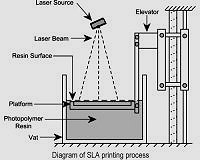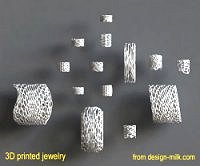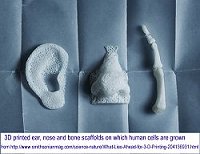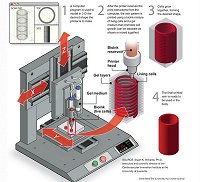

INDEX: How 3D printing works; 3d printing methods.; Applications.; Printing human body parts.; Click illustrations to enlarge
3-D printing has introduced a technical revolution,
it allows engineering prototypes to be produced rapidly and inexpensively.
The science fiction of producing human body parts is becoming a reality.
If the paper feed in your ink jet printer ever got stuck, you saw the same line being printed over and over as the drying ink built up. That in essence is the principle of 3D printing. In normal ink-jet printing, the 2D (two dimensional ) printing program steers the printing nozzle from right to left and instructs the deposition of ink droplets to form a line of drawing or of text. When the paper advances the width of the line, the next pass of the nozzle deposits a slightly different pattern. Thus line by line the complete text or the drawing is formed. After the whole page has been printed, a new sheet of paper is inserted and and a new text or a new drawing is created
In 3D printing, after the first layer has been completed, either the vertical position of the nozzle is raised at least 0.1mm (0.004 inch), which is equal to the thickness of good quality paper, or the supporting table is lowered an equivalent amount, and the process is repeated. In order to build an object the controlling drawing for each layer changes very slightly.
Look at the third slide in the slide show. It shows how a coffee mug would be made with 3D printing. Special CAD (Computer Aided Design) software produces a series of drawings of cross-section slices of the mug, each corresponding to one layer of the printing process. For a 4 inch tall mug up to a 1000 such layers are required. After completion a curing (hardening) process for the plastic may be reuired. If the layers are thicker, the printing time is shorter, but smoothing and polishing will be needed.
A laser scanner may be used to develop the software to copy an exiting object, for example to produce spare parts for an obsolete machine.
 Typical standard manufacturing methods are subtractive, that is material is removed from a base form by machining with a lathe, with a drill, by cutting, planing or broaching. By contrast 3D-printing is an additive process, because material is added, layer by layer.
Typical standard manufacturing methods are subtractive, that is material is removed from a base form by machining with a lathe, with a drill, by cutting, planing or broaching. By contrast 3D-printing is an additive process, because material is added, layer by layer.
Initially 3D printers were very expensive, as much as $500,000. Now, in 2013, printers capable of printing small objects are available for around $2000, for example Replicator 2 from MakerBot. Hobbyists may buy Do-it-yourself kits for a few hundred dollars.
 In a thin layer of liquid photopolymers, the design is solidified by a ultraviolet laser beam steered by the design program, see the illustration above. The unsolidified resin is reused. It was invented in 1984 by Charles Hull who established the company 3D Systems to develop printing machines and the technology.
In a thin layer of liquid photopolymers, the design is solidified by a ultraviolet laser beam steered by the design program, see the illustration above. The unsolidified resin is reused. It was invented in 1984 by Charles Hull who established the company 3D Systems to develop printing machines and the technology.
 For more than half a century, the Wake Forest Medical Center, in Winston-Salem, NC, has been carrying out innovative medical research. Dr. Anthony Atala, director of the Wake Forest Institute for Regenerative Medicine, recognized the possibilities of utilizing 3D printing to build human tissue and body parts. A urinary bladder membrane printed from a bio-degradable material, then coated with the patient's own bladder cells, After the initial cells had multipled and become a new bladder, it was successfully inplanted ten years ago. Since then several more perforated bladders have been repaired the same way. There is no danger of rejection because the patient's own bladder cells are used to grow a new bladder tissue.
For more than half a century, the Wake Forest Medical Center, in Winston-Salem, NC, has been carrying out innovative medical research. Dr. Anthony Atala, director of the Wake Forest Institute for Regenerative Medicine, recognized the possibilities of utilizing 3D printing to build human tissue and body parts. A urinary bladder membrane printed from a bio-degradable material, then coated with the patient's own bladder cells, After the initial cells had multipled and become a new bladder, it was successfully inplanted ten years ago. Since then several more perforated bladders have been repaired the same way. There is no danger of rejection because the patient's own bladder cells are used to grow a new bladder tissue.
 This drawing (click to enlarge) illustrates how a vein may be printed using a patient's own cells. Droplets containing hundreds of cells are injected through the printer nozzle, supported by a gel which later dissolves. Human cells naturally bond together.
This drawing (click to enlarge) illustrates how a vein may be printed using a patient's own cells. Droplets containing hundreds of cells are injected through the printer nozzle, supported by a gel which later dissolves. Human cells naturally bond together.
Printed jaw bones, cheek bones, prosthetic limbs, even a part of a skull, have all been successfully used to help patients suffering severe damage, whether because of accidents or sickness.
Most recently, at the University of Michigan, a baby was unable to breathe because its windpipe was collapsing. A splint was printed and inserted into the windpipe. Now several months later the baby is breathing and growing normally.
Organovo. Ltd, San Diego, is building bio-printers for universities (and Wake Forest) and also conducting research on printing human tissues including replacement skin for burn victims.
Presently there is a severe shortage of replacement organs such as kidneys, livers and hearts. Frequently donated organs are rejected and discarded. Wake Forest Institute for Regenerative Medicine has printed a miniature kidney that is functioning correctly.
Dr. Atala hopes that within his lifetime, it will become a reality that, replacement organs printed using the patient's own cells will be successfully developed and implanted into human beings.
Return to top of page.
Return to Home page
A PRINTABLE version of THIS article
Slide show about 3D printing.
Future for 3D printing,
includes printing new body parts.
3D Systems a major producer of 3D printing machines and materials.
Stratasys, Ltd. a major producer of FDM type 3D printers and materials.
